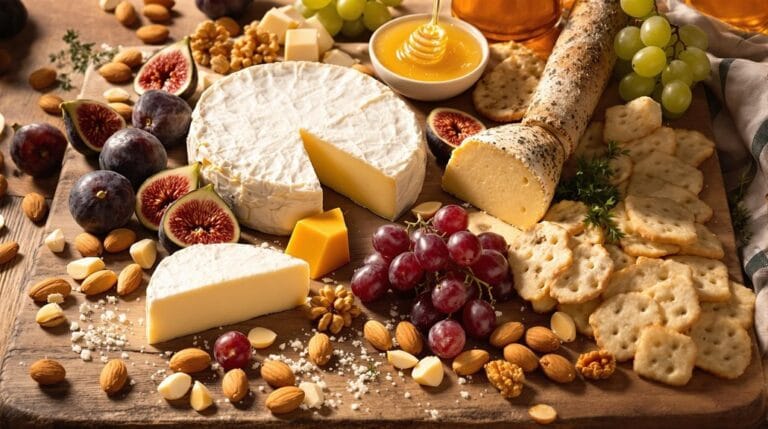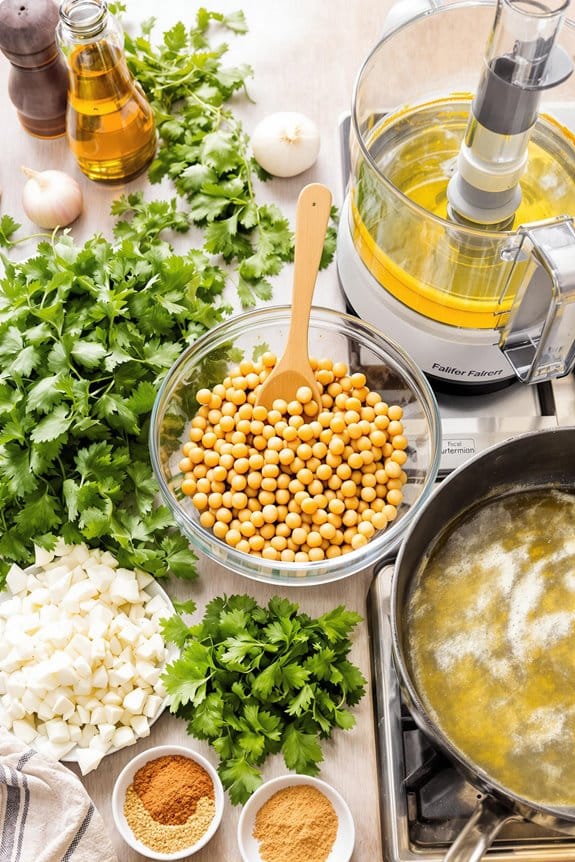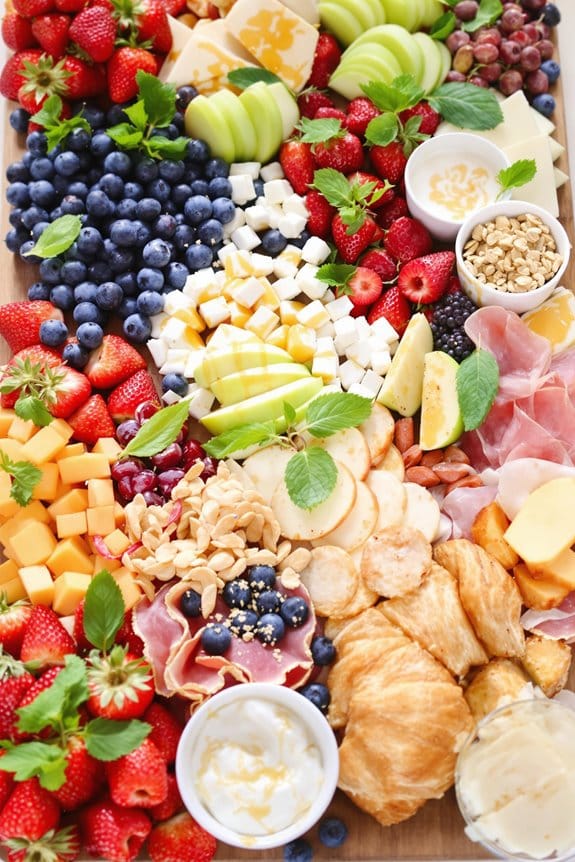Creating a seasonal fruit and dessert platter allows you to celebrate fresh, local produce while enhancing your culinary experience. Start by selecting ripe, seasonal fruits like strawberries in spring or apples in autumn, ensuring a mix of colors and textures for visual appeal. Wash and cut the fruits into bite-sized pieces, then arrange them artistically on a large platter. Don’t forget to include desserts like mini cheesecakes or tarts to complement the fruits. For a delightful touch, serve with dips such as honey yogurt or melted chocolate. This vibrant presentation not only fosters community connections but also invites more exploration of creative serving ideas.
History
Throughout history, people have always enjoyed the vibrant flavors and colors of seasonal fruits. From ancient civilizations to modern-day gatherings, these fruits have played an essential role in culinary traditions worldwide. In many cultures, you’ll find that fruits symbolize abundance and fertility, often appearing in art and literature as representations of nature’s bounty.
During the harvest seasons, communities would come together to celebrate the fruits of their labor, sharing platters that showcased their local produce. In medieval Europe, fruit was a sign of wealth and status, often displayed at banquets and festivities to impress guests. Similarly, in Asian cultures, seasonal fruits are integral to festivals, symbolizing good fortune and prosperity.
Different regions have their unique seasonal fruits, influenced by climate and geography. For instance, tropical areas boast exotic fruits like mangoes and papayas, while temperate zones celebrate apples and berries.
You can appreciate how these fruits not only enhance meals but also foster community and tradition. By understanding this rich history, you can better appreciate the role seasonal fruits play in your own culinary experiences, encouraging you to explore and celebrate the diversity they bring to your table.
Recipe Cooking Steps
Creating a seasonal fruit and dessert platter is a delightful way to celebrate fresh produce and satisfy your sweet tooth. This vibrant dish not only showcases a variety of fruits but also provides an opportunity to incorporate simple desserts that complement their flavors. By selecting seasonal fruits, you guarantee that your platter is bursting with flavor and nutrition, while also supporting local farmers and reducing your carbon footprint.
To craft your platter, consider the fruits that are in season, such as strawberries, blueberries, peaches, and melon. Pairing these fruits with a selection of delicious desserts like chocolate-dipped strawberries, mini cheesecakes, or fruit tarts will elevate your presentation and taste. This platter is perfect for gatherings, parties, or even as a special treat for yourself.
Let’s plunge into the ingredients and steps to create this beautiful and tasty platter.
Ingredients:
- Assorted seasonal fruits (strawberries, blueberries, peaches, melons, etc.)
- Chocolate (dark or milk) for dipping
- Mini cheesecakes or cheesecake bites
- Fruit tarts
- Honey or agave syrup for drizzling
- Fresh mint leaves for garnish
- Optional: yogurt or whipped cream for dipping
To assemble your seasonal fruit and dessert platter, start by washing and preparing your fruits; slice larger fruits like peaches and melons into bite-sized pieces while leaving smaller fruits like strawberries and blueberries whole.
Arrange the fruits artistically on a large serving platter, grouping similar colors together for a visually appealing display. Next, place the mini cheesecakes and fruit tarts among the fruits. Melt the chocolate in a microwave or double boiler, then dip the strawberries into the chocolate and place them on the platter.
Drizzle honey or agave syrup over the fruits, and finish with fresh mint leaves for garnish.
Extra Tips:
When selecting fruits, opt for those that are ripe and in season for the best flavor. Consider including a variety of textures and colors to make your platter more visually appealing.
If you’re short on time, you can also buy pre-made desserts from a local bakery. Don’t hesitate to get creative with the arrangement, and feel free to add other elements like nuts or dried fruits to enhance the platter further.
Enjoy the process and let your creativity shine!
Step 1. Select Fresh Seasonal Fruits
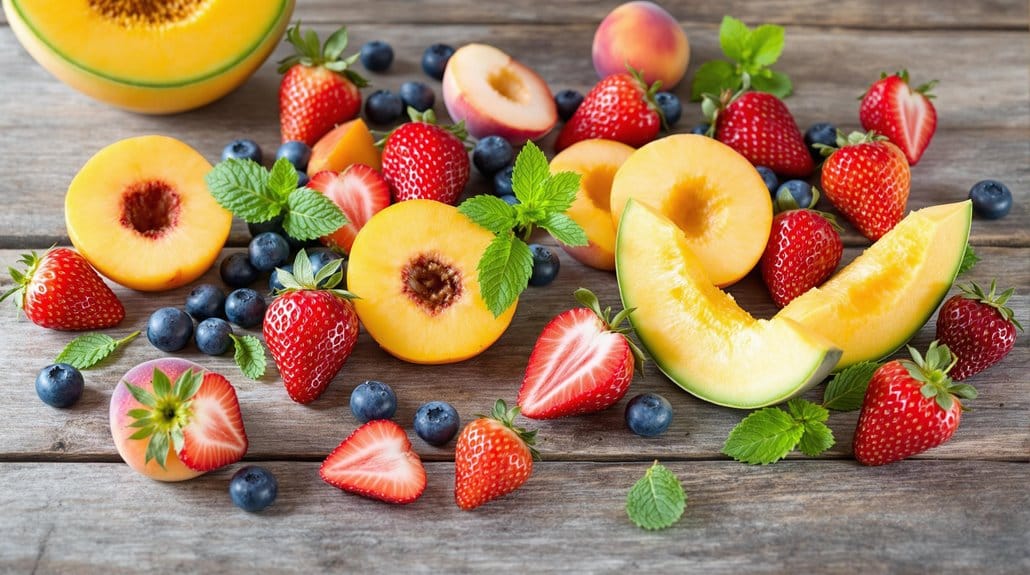
When you’re ready to assemble your seasonal fruit platter, start by choosing fruits that are at their peak ripeness for the best flavor and texture. Fresh, seasonal fruits not only taste incredible but also provide vibrant colors, making your platter visually appealing.
Visit your local farmers’ market or grocery store and look for fruits that are in season. This could include strawberries, blueberries, peaches, or melons, depending on the time of year.
Take a moment to inspect each fruit. Look for smooth skin without blemishes, and gently squeeze to check for firmness. For example, a ripe peach should yield slightly to pressure, indicating juiciness. If you’re unsure, ask a vendor for recommendations on what’s fresh that day.
Don’t shy away from including a variety of colors and textures; it’ll enhance both the aesthetics and flavor profile of your platter.
Think about adding citrus fruits like oranges or grapefruits for a revitalizing twist, or consider tropical options like pineapple or mango for a touch of the exotic.
Step 2. Cut Fruits Into Bite-Sized Pieces
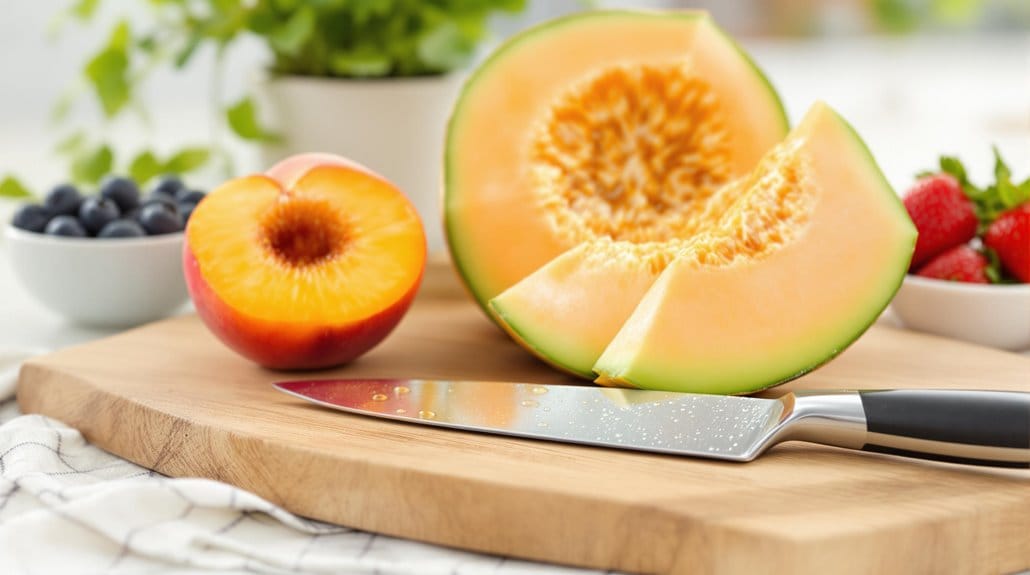
Now that you’ve selected a colorful array of fresh seasonal fruits, it’s time to cut them into bite-sized pieces for easy serving and enjoyment. This step not only enhances the presentation but also makes it simpler for guests to indulge without the fuss of cutting.
Here’s how to do it effectively:
- Wash the Fruits: Rinse your fruits thoroughly under cold water to remove any dirt or pesticides. Dry them with a clean towel.
- Peel If Necessary: For fruits like kiwi or mango, you’ll want to peel them first. Use a sharp knife or peeler for a clean removal.
- Cut Uniformly: Slice fruits into similar sizes; this guarantees they look appealing and are easy to eat. For example, cut strawberries in halves or quarters, and slice apples into wedges.
- Remove Seeds and Pits: Be sure to remove any seeds or pits from fruits like cherries or peaches before cutting. This step is essential for both safety and enjoyment.
Step 3. Arrange Fruits Artistically
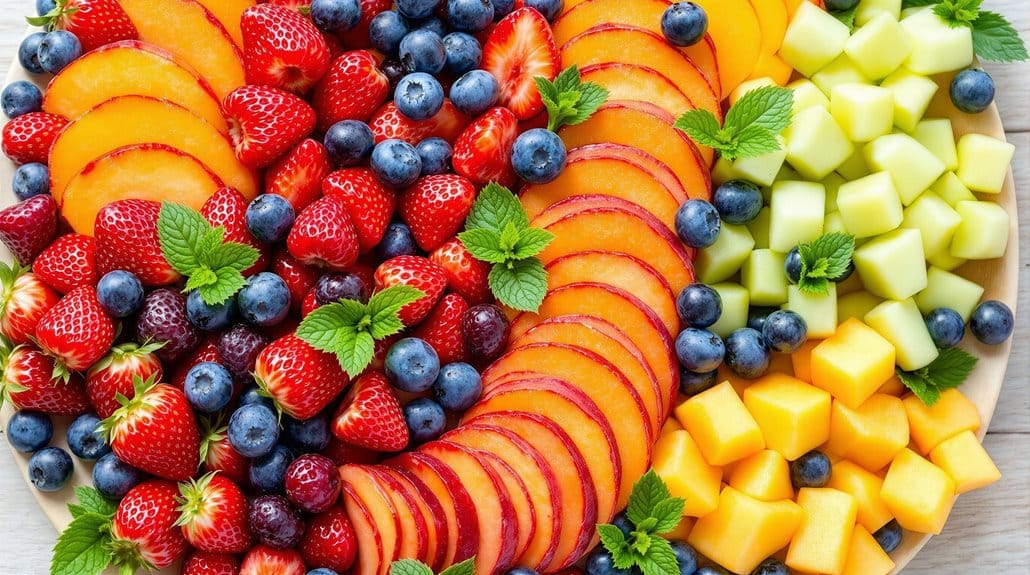
A vibrant platter of cut fruits not only tempts the taste buds but also adds a splash of color to your table. To arrange your fruits artistically, start by selecting a large, flat serving platter that provides ample space for creativity.
Begin by placing larger fruits, like watermelon or pineapple, in the center. Their size will anchor the display and draw the eye. Next, fill in the gaps with medium-sized fruits such as strawberries and kiwi, arranging them in a circular pattern to create a harmonious flow.
You can then scatter smaller fruits, like blueberries and raspberries, around the edges for a pop of color. Consider using contrasting colors and shapes to create visual interest; for instance, the vibrant orange of a sliced peach pairs beautifully with the deep purple of grapes.
Don’t forget to vary the heights of your fruit pieces, stacking some slices or using small bowls for berries. This adds dimension and keeps the arrangement engaging.
Finally, step back and assess your platter—make any adjustments for balance and symmetry, ensuring it looks as delightful as it will taste. With just a bit of thought, you’ll create a stunning centerpiece that invites everyone to indulge.
Step 4. Add Dips and Garnishes
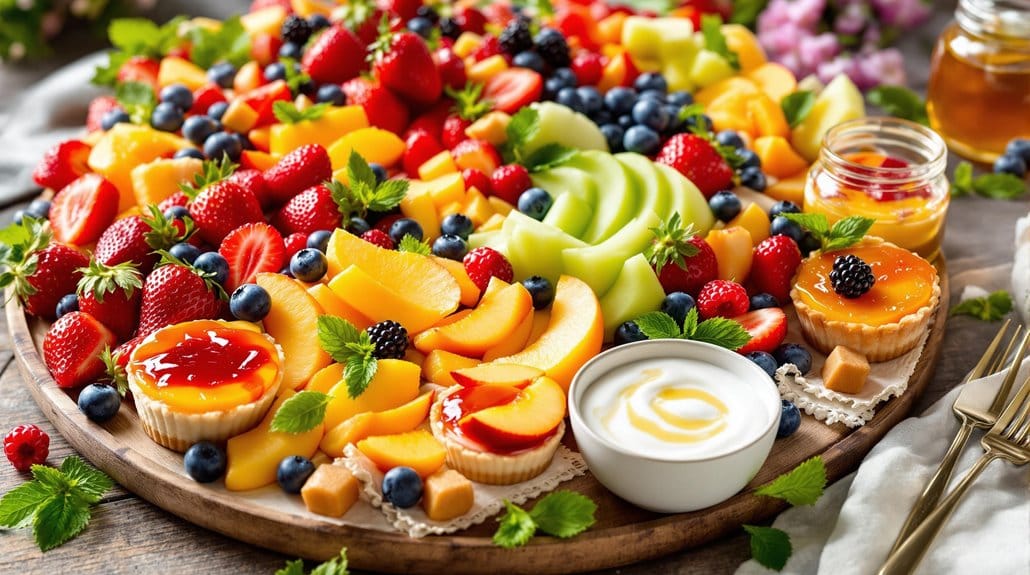
Enhancing your seasonal fruit platter with dips and garnishes elevates the entire experience, making it even more inviting and delicious.
You’ll discover that the right dips can complement the sweetness of your fruits, while garnishes add a pop of color and texture. Here are some tasty ideas to ponder:
- Honey Yogurt Dip: Blend Greek yogurt with honey and a squeeze of lemon juice for a creamy, tangy dip that pairs wonderfully with berries and apples.
- Chocolate Fondue: Melt dark or milk chocolate for a rich dipping option that will delight kids and adults alike. Serve with strawberries, bananas, and marshmallows for a fun twist.
- Cinnamon Sugar Sprinkle: Combine cinnamon and sugar to create a sweet sprinkle that adds a delightful crunch to sliced fruits like pears and peaches.
- Mint Leaves: Fresh mint leaves not only bring a vibrant green color to your platter but also offer a rejuvenating flavor that enhances the overall fruit experience.
Step 5. Serve Chilled for Refreshment
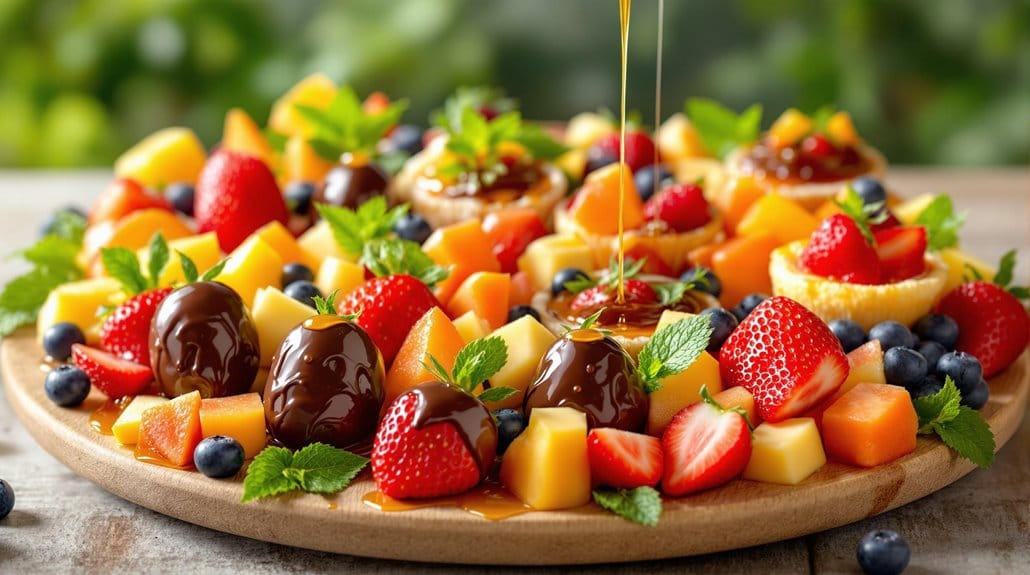
To truly enjoy your seasonal fruit platter, serving it chilled is key to maximizing coolness.
Begin by selecting a variety of fresh fruits, such as strawberries, kiwi, and watermelon, which aren’t only delicious but also visually appealing. Once you have your fruits, wash and slice them into bite-sized pieces.
Next, place your fruit in a large bowl or on a beautiful platter. To enhance the chilling effect, cover the platter with plastic wrap and refrigerate it for at least one hour. This step allows the flavors to meld and guarantees that each fruit remains crisp and invigorating.
For an extra touch, consider chilling the serving dishes as well. You can place them in the refrigerator or freezer for a short time before serving. This detail elevates your presentation and keeps the fruit cool longer.
When it’s time to serve, garnish your platter with fresh mint leaves or a sprinkle of coconut flakes for added flavor and texture.
This simple yet effective method not only enhances the visual appeal but also makes your seasonal fruit platter a delightful centerpiece for any gathering. Enjoy the invigorating burst of flavors!
New Recipe
- Pepperoni and Hot Honey PizzaTry the tantalizing twist of pepperoni pizza with hot honey, where sweet meets heat—how will it transform your taste buds?
Final Thoughts
Creating a seasonal fruit and dessert platter can elevate any gathering, bringing color and flavor to the table. This delightful presentation not only pleases the eye but also tantalizes the taste buds, making it a memorable addition to your events.
It’s a simple yet effective way to showcase the best of each season’s bounty while offering guests a variety of options.
To guarantee your platter shines, consider these key elements:
- Seasonal Selection: Choose fruits that are at their peak, like strawberries in spring or apples in fall, to maximize flavor and freshness.
- Variety of Textures: Incorporate a mix of soft and crunchy fruits, along with creamy desserts, to provide an interesting mouthfeel.
- Color Coordination: Arrange fruits in a way that highlights their vibrant colors, creating a visually appealing display that draws guests in.
- Complementary Pairings: Think about how different flavors work together; pairing tart fruits with sweet desserts can create a balanced experience.
Bottom Line
Creating a seasonal fruit and dessert platter not only showcases the vibrant flavors of fresh produce but also brings a sense of community and celebration to your gatherings. By selecting ripe fruits, arranging them with care, and offering delightful dips, you can elevate any occasion. Remember to serve your platter chilled for the most invigorating experience. With these simple steps, you can impress your guests while promoting the joys of seasonal eating, making every bite a delight.






